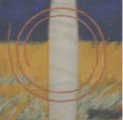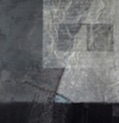
I often read texts by favorite artists, such as Paul Klee, Kandinsky or even earlier painters like Van Gogh. A painter's life is often solitary and these texts have helped me immensely in my artistic development. And they naturally provoke further reflections, as part of any dialog would, so here are a few texts that I have written over time.
Some Leads
I like to let people formulate their own ideas. The interaction between the work and the spectator's view of it, their impressions, associations and speculations on meaning and feeling are vital and just as true as what my own dialog with the work was as it evolved. The painting has its own life and must be able to stand on its own. But many times I am asked to speak about my painting, so I'd like perhaps just to give a few hints at what is behind it.
There often are geometric shapes : geometry tells a story and forms emit vibrations. But we should also consider the double influence of Chinese thought (especially Taoism) and Navajo and Hopi cultures from the southwestern United States. I feel there are parallels to be drawn and echoes to be heard between these cultures, especially in certain forms of symbolism and in the images used to speak of the world...
Painting is a means for me to explore these ideas with non-verbal language, which makes it easier to associate rationality and irrationality. A few examples...
Take the square, for instance. It has four flat sides, all at right angles, perpendicularity which in itself implies spatiality between the vertical and the horizontal. On the horizon there is a standing man. There, between Earth and Sky (a taoist vision of man's place).
A square can also be a space; a piece of land, lying flat like a map. For the Chinese the square represents the Earth and its cardinal points. It evokes stability and materiality.
But in some paintings, if it is empty it becomes a window or a door, a place to pass through.
Then take the circle. In Chinese thought the circle represents the sky, the celestial dome. A circle makes one think of cycles, so there is time and movement. There is also the idea of globality and unity. It is an ensemble, a point, the one. And if we are in the middle and turn around it is 360°, the whole.
The spiral is an open circle in movement. It includes transformation. If you think of the four seasons of the year, every year they repeat themselves, but each time we are different. Some things are the same and others different. We are not exactly at the same point and neither are we exactly the same person. The spiral can also represent energy, potential energy as in a spring, or the trace left by a movement...
I also need to speak about the materials I use. Paper, yarrow stalks or bamboo, pigments and earth, ochres and beeswax. They provide a presence that is both tactile and emitter, as well as their symbolic references.
I feel a need to nourish myself with the "hands-on" contact with wood or paper and to delve into the process of making, be it with weaving, tying things together, writing or simply resting my eyes on an irregular surface. The elements themselves have their healing effect.
Lin Schmidt (2002)
What is Painting? (Why I paint)
Perhaps a way of leaving traces where we have been, to know more where we are going. But because we are on a path, and everything we do has its importance, it’s important for me to carefully choose the materials I use. Painting is not just a question of an image, which is perceived by the eye and analysed by the mind. There are more subtle interactions. The whole body is capable of perception. This explains why we feel attraction for something or someone. Or why in some environments we can experience uneasiness or on the contrary well-being and comfort. Because the material world is composed of vibration, the very structure, composition, and surface of the work influence how we interact with it. I do not produce works that make social statements. I prefer to create works that will give something to the perceiver. Be it an idea or sense of calm or simply a good feeling. Like Beuys, I feel that art has a mission of healing, and that is what we are here for.
More background Info
1970/74 Studied at Blackburn Université in Illinois and SchillerCollege in Paris, France. BFA in Art and Psychology.
Raised on images of Pollack, O’Keefe, Rauschenberg, J Johns in the States, then in Europe felt a deep écho seeing Rembrandt, Giotto, and the other masters in European museums.
1975/76 voyages in the USA and in Europe on bicycle. Visited more great European museums : Cranach, Dürer, Botticelli !
1977/79 Returned to Chicago and worked for the MCA - met different artists: Robert Mangold, Robert Ryman, Phil Berkman...
Participated in a cooperative gallery in Chicago
1979/80 went to Bordeaux to study Chinese and to continue research on the I Ching. Met the painter Robert Boutiq
1981 They moved to Tarbes to set up their art studios
1983 First series of paintings on the I Ching
1986 Evolution towards the structures - dialog painting/sculpture
1987 Began to teach tai chi chuan
1988 Moved the studios to Louit (in southwestern France)
1990 Show in Mourenx with R Boutiq
1991/93 Began to incorporate text as material : as texture and also as presence in meaning, the poetry of Li Po, Ezra Pound, T.S. Eliot...
1995 Began using encaustic media more and more
1995/98 Beginning of the themes of the messenger, door/window, spiral...
1999/02 Beginning of the theme ‘bu’, or consulting the oracle
2002/06 the loss of Robert, my soul-mate, then my mother, also moved back to Tarbes
2007/08 setting up the studio in Tarbes. reconstruction...
2009... Focusing on painting, it's time to get to work!
Some Leads (clues to interpreting my geometrical references)
On Painting (why I paint)
More Background Info on the artist


Texts on Painting
On the Techniques I use
On the importance of Obsevation (the first act of painting)
Reflexions on different Materials used
On the techniques I use
After experimenting with all sorts of traditional techniques, from oils, acrylics, watercolors etc., I have developed my own preferred “cuisine”. I use the technique that appeals to me at a particular moment. I most often use paper, in various forms from sheets to woven strips to paper maché, with pigments, ashes, plant fibers and resins or other binders such as beeswax on paper, wood or canvas or a combination of the 3.
I generally make my own paints from pigments and resins. Sometimes they are water-based and sometimes they are traditional encaustic paints, which are a blend of pigments, Dammar resin and beeswax applied to a surface using heat.
I apply many layers to enrich the surface to make it even more solid for the encaustic layers in the end, and to begin my conversation with the canvas. The materials themselves also condition the painting, teaching my hands what to do with them.
Just as in cooking I can feel hunger for a color or decide to add a little flavor with some text texture. Not just any text will do. I must find the one that is needed for the particular painting. It can be from a book that I am currently reading (as happened for the Aztec Pyramid Series) or there might be a need for a specific poem from one of my favorite poets... It's a way of incarnating the poem into the painting.
And then of course to create a harmonious whole I often refer to the golden rule in its infinite variations. Because for me art has a very important function. To be beneficial and to help its environment.
Observing, ever and again it seems I have always been ... observing.
Observation has taught me quite a lot. In my childhood already I loved looking longly at the grain of wood in some doors and the patterns the ceramic tiles made in my Grandmother's bathroom. You can see various beings and find different patterns depending on how you look at them. As well as lying beneath a big tree in the summer, watching the delicate lacework of leafy branches against the blue sky. I could spend hours doing so.
A little later I contemplated reproductions of my favorite painters, then discovered the real thing in museums, finally "face to face" with the works. I had many influences. First as a child they were Picasso and Lautrec. Later, while living in Chicago, they were Miro, Motherwell, Rothko, and Kandinsky. Then, in Europe, just awed by the paintings of Giotto, Fra Angelico, Dürer, Vermeer...
Returning to Chicago my observing was to continue. As a museum guard in the Museum of Contemporary Art I had all day long! This was more instructive than my studies for my Fine Arts diploma.
Living with the same show for a full month taught me enormously. Sometimes my first impressions held true, and sometimes they were all wrong. What is it that makes a work of art profound? That keeps it interesting for a long period of time?
It was the time of minimal art. One minimalist could disturb me or bore me after awhile, whereas another could continue to reach and question me. So it is not at all a question of style or tendency. Neither is it a question of "school" or subject. What made me react differently was vibrations. Perhaps our individual perceptions are unique despite our universal background as human beings. In any case some works would remain merely anecdotal and others were amusing with an ironical touch. But the best ones are those of healing, either by a feeling of well-being or by a confrontation with onesself.
On Materials
Materials contain their own vibration within. Added to this are associations we make by analogy :
earth : clay, with water it's the origen of life...
yarrow : a medicinal plant that is also used in divination using the I Ching, one of the oldest books in the world.
pigments or ashes : often produced by fire, witnesses of transformation
beeswax : a protective and harmonising element
resins : sometimes vegetable sometimes mineral origen, a hardener
texts and writing : incorporating the idea into a graphic element, tha remains accessible to others, linking the verbal to the non-verbal
By the process of weaving together and interlacing, observation, action and rest, the choice of materials, the choice of texts, and colors, passing through the water of color washes and the fire of encaustic painting. All these things leave traces of their passage.
Lin Schmidt (2002)
